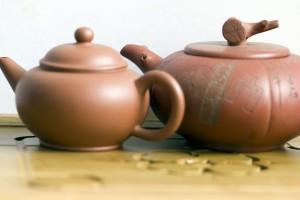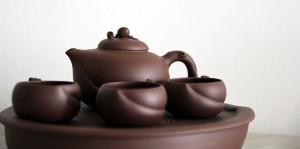If you have tea loving friends or frequently surf tea related sites, you might have come across the phrase ‘zisha pot’ or more frequently in English writings- Yixing pot.
Zisha pots are virtually a most have among tea connoisseurs and in some circles, it appears to be a matter of bragging rights.
For the uninitiated, here is a proper look at what is a Zisha Pot aka Yixing Pot.
What’s in a name?
For starters, let us look at the name.
Zisha (紫砂) is literally translated as ‘purple clay’ and Zisha can be further sub-divided into zini (紫泥), lvni (绿泥) and hongni (红泥) which means purple, green and red clay respectively.
This unique unglazed clay is mined in Yixing (宜兴) County in Jiangsu Province, from where it gets its other common name.
There are conflicting accounts when it originated but it was believed to be either the late Song Dynasty or the Ming Dynasty. In any case by the Ming Dynasty, it was already widely in use, most popular for the production of vessels for brewing tea.
What’s so special about a Zisha Pot?
Zisha pot is virtually synonymous with gongfu tea and it is favored for these reasons:
 Insulation
Insulation

The Purple Clay is one of the best heat insulating materials used in teapots. This makes it especially popular in either cold climates or for making teas that require high heat to unleash the flavor such as oolong teas.
Correspondingly, this characteristics means that one would not get one’s fingers burned holding a Zisha Pot as compared to glass or metal .
Handles Changes in Temperatures
Genuine Zisha Pots won’t crack when it undergoes huge changes in temperatures in a short period of time. This means that even in cold climates, you can pour boiling water straightaway without fear of cracking your precious pot.
In fact, one way of eliminating undesired odors from Zisha Pots is to repeatedly take turns dousing it with hot and cold water. The rapid expansion and contraction of the clay will cause it to lose the odors it previously absorbed.
Which brings us to the next point……
Seasoning
Zisha Pots are one of the few utensils with excellent resale value. With repeated usage, the material absorbs the fragrances and taste of teas previously brewed in it and over time, even plain water poured into it will have a lingering flavor of the tea it was seasoned in. This is due to the porous nature of the unglazed clay that is highly absorbent in nature.
As such a well-seasoned pot can accentuate the taste of subsequent brews.

As for how you define ‘a particular type of tea’, it is contentious.
There are some that espouse the theory that 2 will do- 1 for heavily roasted and 1 for lightly roasted, this being more of the case for oolong, arguably the most natural pairing with Zisha Pots.
Then at the other extreme you have those who go right down the mountain and the style of each tea.
Personally, I am more inclined towards the former- although I think 5-6 pots might be more apt.
My rationale is simple- first is finances and second is that how often you would use each pot if you divvy to that level of detail.
Do you drink a mid-roasted Huang Zhi Xiang from Mt Wudong every other day? If you had 50 pots, how long would you take to season each one properly?
Shine
Zisha Pots are not only seasoned on the inside, they are seasoned on the outside as well. The first infusion- known as rinsing- is usually poured on the outside of the pot to serve 2 purposes- one is to maintain the heat and the other to allow the tea oils to be absorbed by the pot and render it shinier.
Many tea lovers even use a brush to spread the oils evenly or lightly brush the tea leaves on the exterior of the pot for the same purpose.
A Parting Note
Unfortunately as the average Chinese increases in affluence, the prices of Zisha Pots are on the rise. This is accentuated by the rarity of the clay.
Buying Zisha Pot therefore becomes a somewhat perilous activity as fakes flood the market and prices of genuine pots are often prohibitive.
Nevertheless the benefits of getting one are worth the trouble.
Disclosure: At point of writing we do not sell any Zisha Pots.
What? You think we mercenary merchants blog for the sole purpose of selling you something? :p
See more articles on Tea Wares
